Some of the links in this post may be affiliate links.
Anthuriums make a great addition to your indoor garden as they steal the show with their uniquely decorative foliage. The genus exhibits incredible diversity and species comes in many colors, sizes and shapes. Here is a guide to the most beautiful and popular Anthurium varieties.
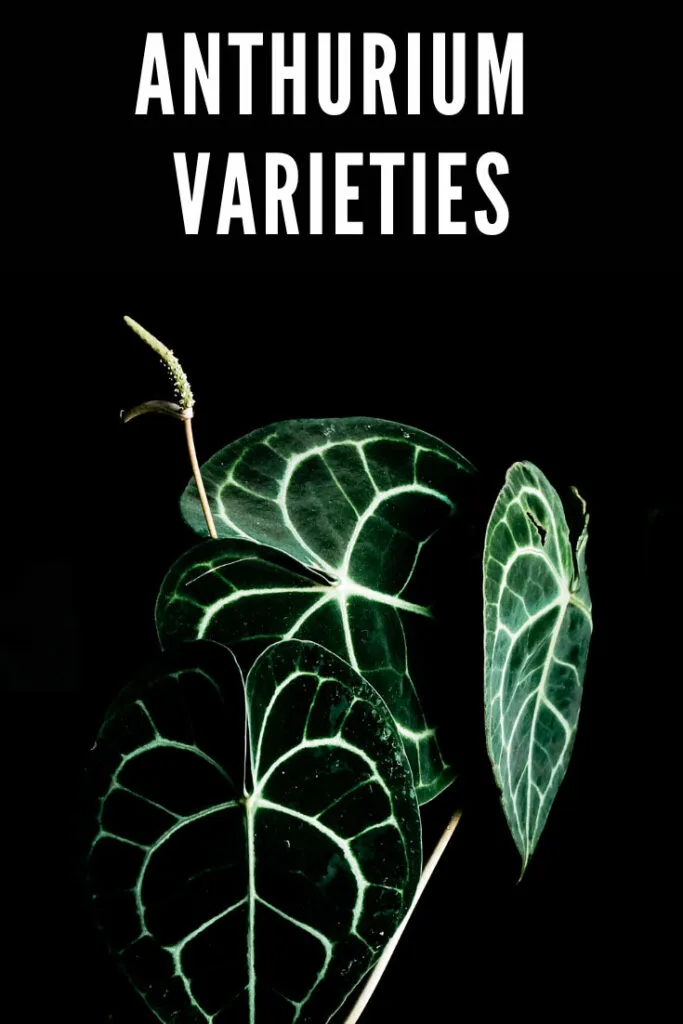
Anthuriums have become very hot houseplants as a result of their highly ornamental foliage. Most are grown for their foliage, but they also produce long-lasting, inflorescences.
The inflorescence (what most people would call the “flower”) has two main structures: the spadix and the spathe.
The spadix is the central structure which contains many tiny flowers. The spathe is the leaf-like structure behind the spadix. Many spathes have a waxy appearance, with some that come in bright colors such as red, pink and even orange.
Native to Mexico and much of South America, the Anthurium genus boasts more than 1100 species and are highly sought-after plants.
Here is our list of 21 most beautiful varieties of Anthuriums which deserve a spot in your collection.
Table of Contents
21 Unique and Beautiful Anthurium Varieties You Can Grow
1. Anthurium ‘Ace of Spades’
Anthurium ‘Ace of Spades’ is a popular plant known for its big, bold foliage. The leaves have a characteristic heart shape with deep venation and velvety surface.
The foliage colors range from green to burgundy, depending on the maturity of the leaves. The price of the plant increases with the leaf size, which can reach around two feet tall and wide.
‘Ace of Spades’ would love a location in your home with bright, indirect sunlight. In front of an Eastern facing window with gentle morning sun is also great.
Maintaining high humidity is a must, considering the tropical origin of this aroid. Use a well-drained potting mix with balanced moisture levels to maintain a steady growth rate.
2. Anthurium ‘Dark Moma’
Anthurium ‘Dark Moma’ (sometimes coined “Dark Mama”) is a hybrid of Anthurium that blends the best characteristics of its parents – Anthurium warocqueanum and Anthurium papillilaminum.
It features thick, velvety green foliage with yellowish venation. The size of the leaves can grow around 12”-16” long.
‘Dark Moma’ thrives in bright, indirect light indoors in front of a window. Eastern exposure windows with gentler morning sun also work well.
3. Anthurium clidemioides
Anthurium clidemioides are easily recognizable with their remarkable looking bullate leaves. The blister-like swellings on the leaves add an intense amount of texture, giving an exotic appearance to the plant.
The plant responds differently to different light intensities by producing dark green to black colored leaves in low-light conditions and bright green color with higher light exposure.
Clidemioides require higher humidity levels, considering their natural habitat conditions. They are terrarium-friendly but certainly not for beginners as the plant involves high maintenance and precise care.
4. Anthurium crystallinum
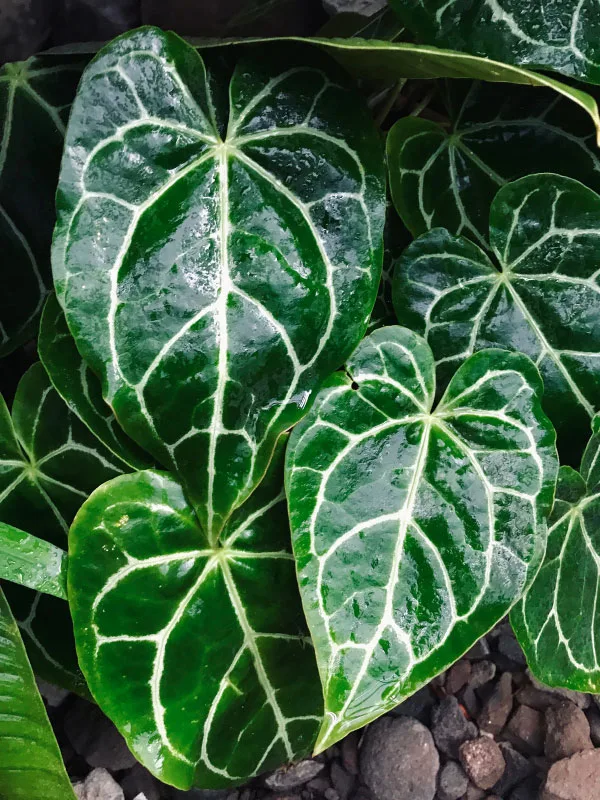
Anthurium crystallium is native to Panama and Colombia. It is a popular houseplant choice for its mesmerizing foliage featuring long, cordate leaves with a velvety texture and silvery venation.
A closer inspection of the leaf reveals its shiny side, which looks like thousands of glittery crystals covering the surface – the reason why the plant is known as Crystal Anthurium or Crystal Laceleaf.
Interestingly, the plant also produces delicate, mildly fragrant flowers that have yellow or red tails with green spathes.
5. Anthurium cutucuense
Anthurium cutucuense doesn’t quite tick the boxes of how a typical Anthurium looks like. There are no heart-shaped leaves, and instead, the plant displays unique trisect leaves with a bullate texture.
It is endemic to only two regions of Ecuador, making it one of the rarest varieties of Anthurium in the world.
The plant does well in humid but cool conditions that mimic its native habitats. It is sensitive to extreme weather conditions and cannot tolerate root disturbances.
Most of the commercially available cutucuenses are not ethically sourced and illegally transported from the forests.
This is a finicky Anthurium, and your best chance at success would be to grow this in a terrarium or a greenhouse.
6. Anthurium forgetii
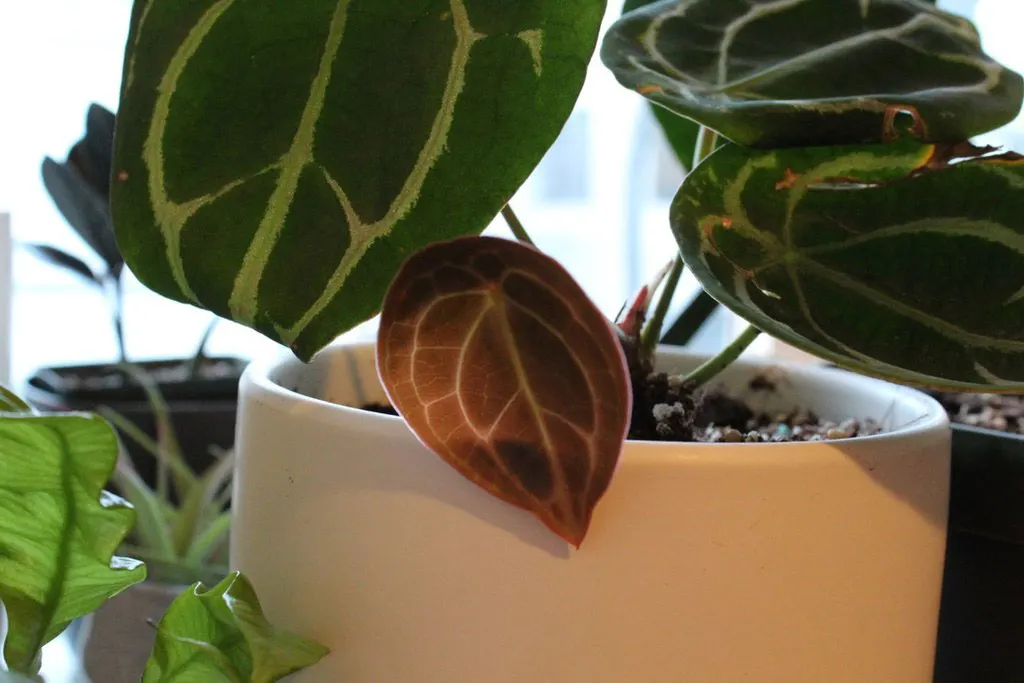
If you are looking for a unique variety of Anthurium to add to your collection, look no further than the Anthurium forgetii. The green foliage has prominent silvery venation and sometimes appears to be almost black.
The plant’s slow-growing nature and compact size make it an ideal pick for spots with space constraints.
It needs consistently moist but not wet soil that is loose and chunky. Bright, indirect sunlight is ideal and consistent humidity levels are a MUST for a healthy growth.
7. Anthurium luxurians
Anthurium luxurians is one of the most expensive varieties of Anthurium as a result of its rarity and visual appeal.
Luxurian, as the name implies, looks incredibly luxurious with its glistening green leaves with blister like texture.
Juvenile leaves with light green color mature into dark green. It naturally grows in the rainforests of Colombia but can adapt well as a houseplant under the right conditions.
The plant prefers 70% humidity levels at all times combined with bright, indirect sunlight. It cannot tolerate mid-day heat, so be sure to shift it to a comfortable place in summers.
8. Anthurium papillilaminum
Native to Panama, Anthurium papillilaminum knowns how to hog the limelight with its breathtakingly beautiful foliage. The pointy leaves can grow up to 13 inches long and look like heart-shaped sheets of velvet that you can’t resist touching.
The plant is quite scarce, making it all the more irresistible for Anthurium collectors. Young leaves have a burgundy color that matures into dark green.
Care wise, the plant prefers typical Anthurium growing conditions, which include warm temperatures, high humidity, bright and indirect sunlight with well-draining soil.
An occasional dose of fertilizer boosts its growth and help the leaves attain their maximum size.
9. Anthurium regale
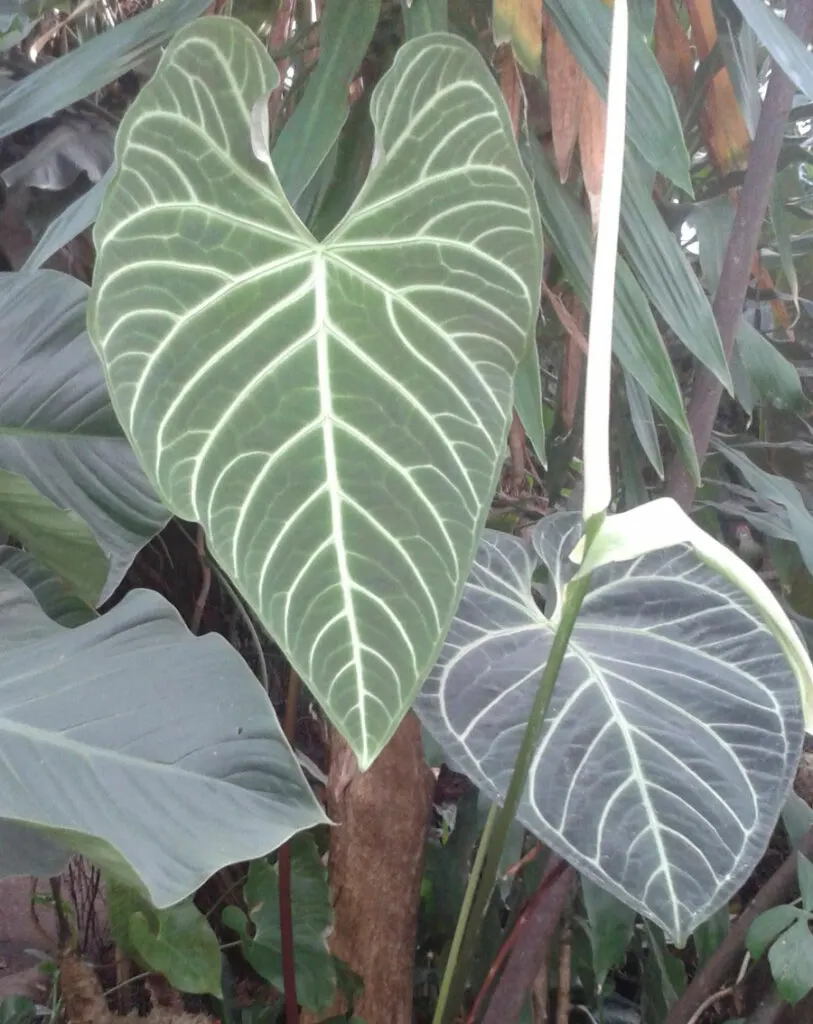
Native to Peru, Anthurium regale is a fascinating, stately plant. The leaves are large and gorgeous with a plush velvety surface and yellowish-white veins. In favorable conditions, the leaves can grow up to 90cm or longer.
While the plant does produce flowers, the foliage is the true star of the show.
This is an indoor plant with similar growing requirements as other Anthuriums. Well-draining soil, warm temperatures, high humidity levels and bright, indirect sunlight create the right environment for the plant to grow its best.
10. Anthurium rotolantei
Anthurium rotolantei looks texturally similar to that of an Anthurium cutucuense with a slightly more pebbled leaf surface.
It is a recently discovered variety of anthurium, named in honor of Denis Rotolante, a renowned aroid grower in the United States. The plant falls in the list of rare varieties of Anthurium which is available with only a few growers in the country.
However, rarity doesn’t mean fussy as the plant is known to be easy growing and relatively low-maintenance. It shares the same growing environmental conditions as the other anthuriums.
11. Anthurium veitchii
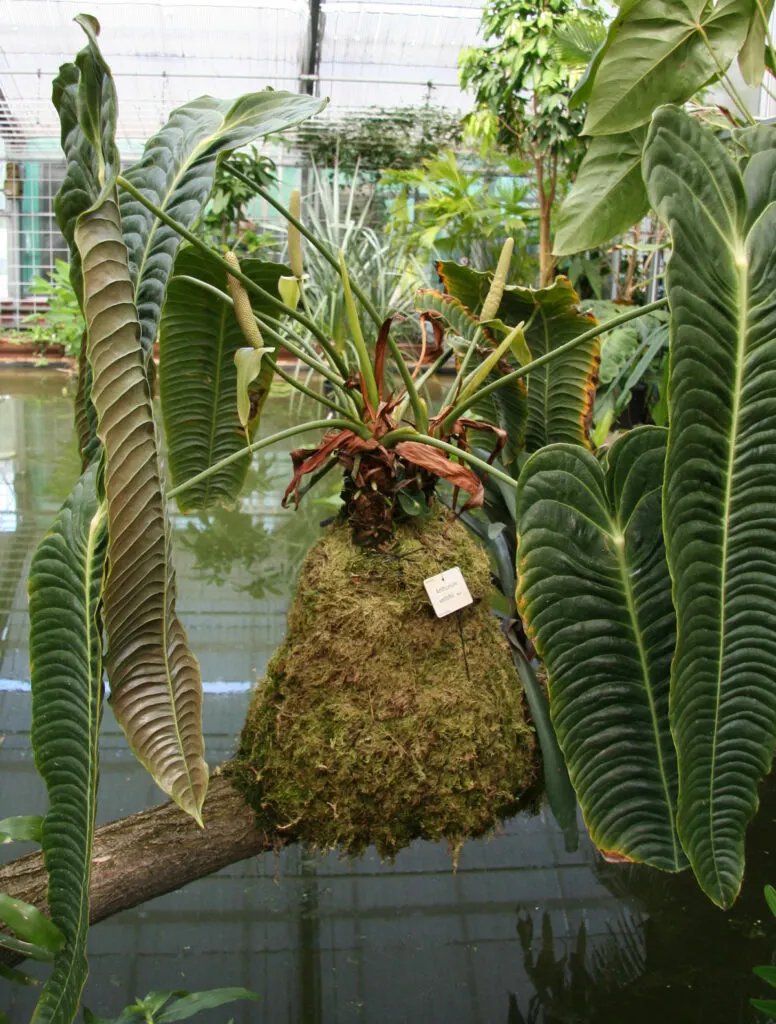
Make way for the “King Anthurium” as he commands your attention with his nearly 6 feet long leaves! Native to the South American rainforests of Colombia, the Anthurium veitchii has one of the longest growing leaves in its family.
Apart from the size, the strong corrugation on the leaves gives it a commanding presence.
Anthurium veitchii grows as an epiphyte on other trees in its natural habitat and works wonderfully well as an indoor plant.
It’s a slow-growing plant and takes about 3 months to produce a new leaf. So, patience is the key! Growing tips include keeping the roots airy with loose, chunky potted mix and maintaining at least 60% humidity levels with damp potting mix.
12. Anthurium villenaorum
Anthurium villenaorum is another rare anthurium variety grown for its attractive foliage. The cordate leaves have a velvety surface with greenish-white veins.
In its natural habitat, the plant grows as an epiphyte on other trees whose dense canopy protects it from harsh sun exposure.
While the plant enjoys dappled or bright, indirect sunlight, it’s better to minimize light exposure during the juvenile stage. Give it lots of humidity with loose, aerated soil to keep the roots airy and free.
13. Anthurium warocqueanum
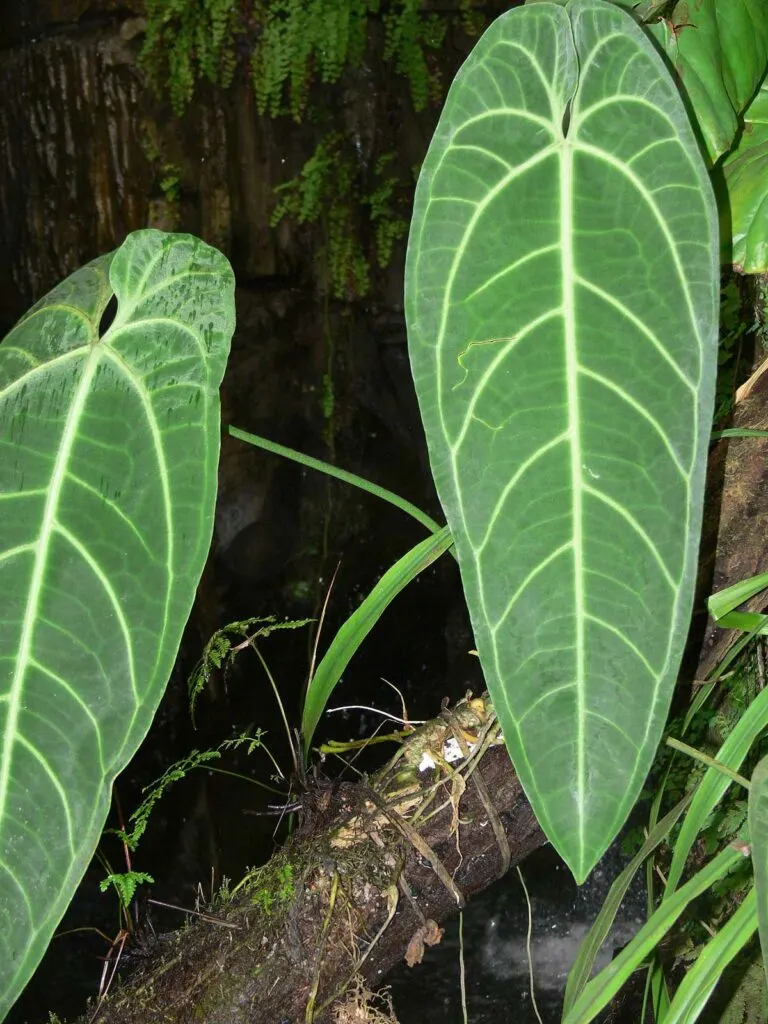
Anthurium warocqueanum is the ‘Queen Anthurium’ and looks regal with its narrow, pointy leaves. The size of the leaves can reach around 4 feet in length – A queen for a reason!
The leaves have a rubbery appearance with bright yellow venation.
The plant is a humidity lover and grows well in well-drained, moist potting mix. It is also a heavy feeder and demands occasional doses of fertilizer to reach its ideal size.
You can expect a change in leaf size and pigmentation that ranges from dark to light, depending on the ecotype it is placed in.
This is not the easiest Anthurium to grow, so don’t add this too early to your plant collection until you can comfortably grow other Anthuriums.
14. Anthurium wendlingeri
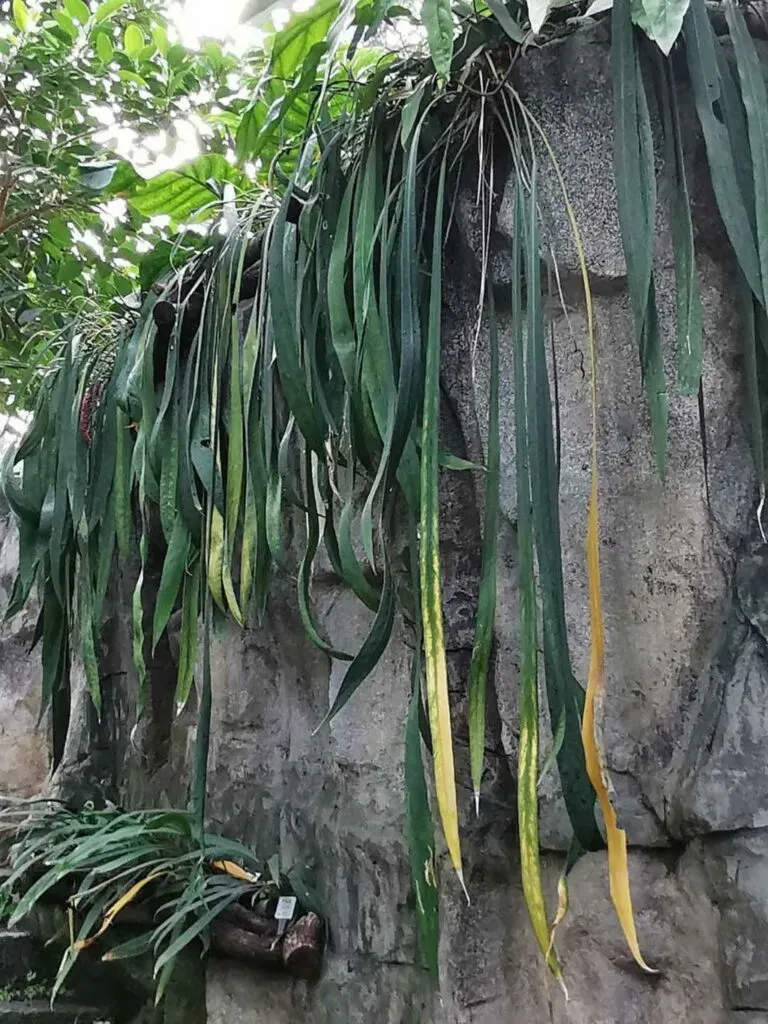
Native to Nicaragua to Colombia, Anthurium wendlingeri is one of the most exotic looking anthurium varieties. The plant features long, dangling strap leaves and an inflorescence with a twisted spadix.
It is also one of the high-priced anthurium varieties.
Repotting must be done with care as the plant has a sensitive root system that is prone to transplant shock.
15. Anthurium polyschistum
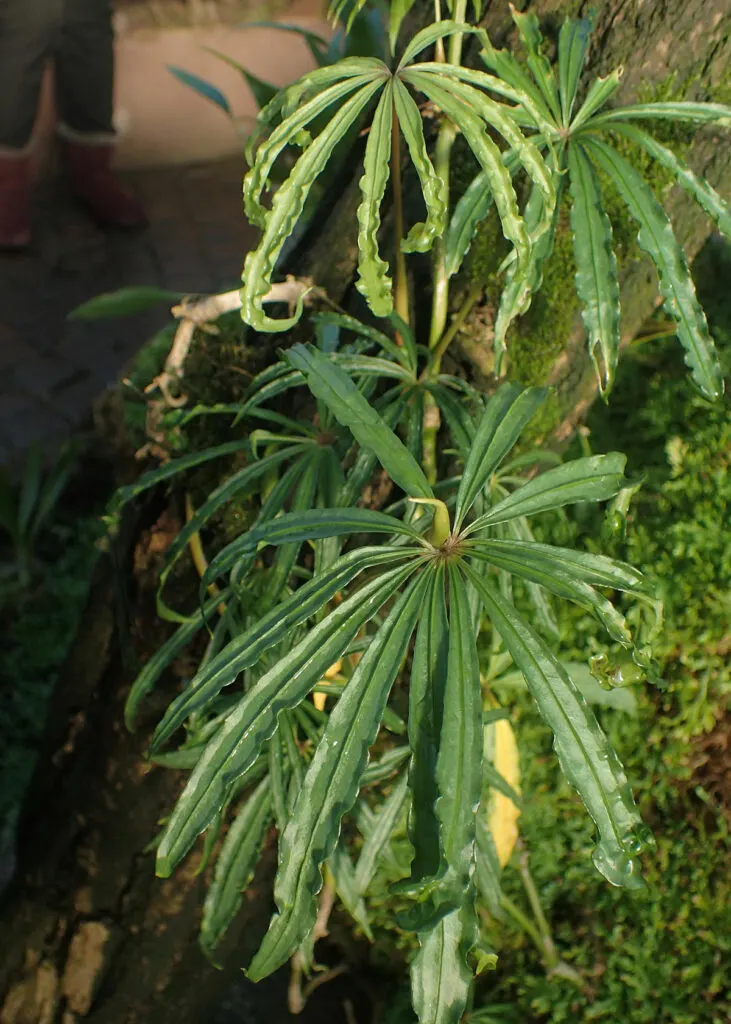
People often mistaken this anthurium variety for hemp because of the split leaf shape and size. Anthurium polyschistum is an interesting plant which lives as an appressed epiphytic climber that grows close to a host plant, usually a big tree.
It can grow from ground to top or from top to the ground to deposit the roots, depending on where the seed was planted.
The leaves have 5 to 9 leaflets which can come in dark green to light green colors. The waxy surface of the leaves creates beautiful visual effect with light exposure.
This plant requires plenty of humidity, dappled sunlight with well-draining soil mix.
16. Anthurium clarinervium
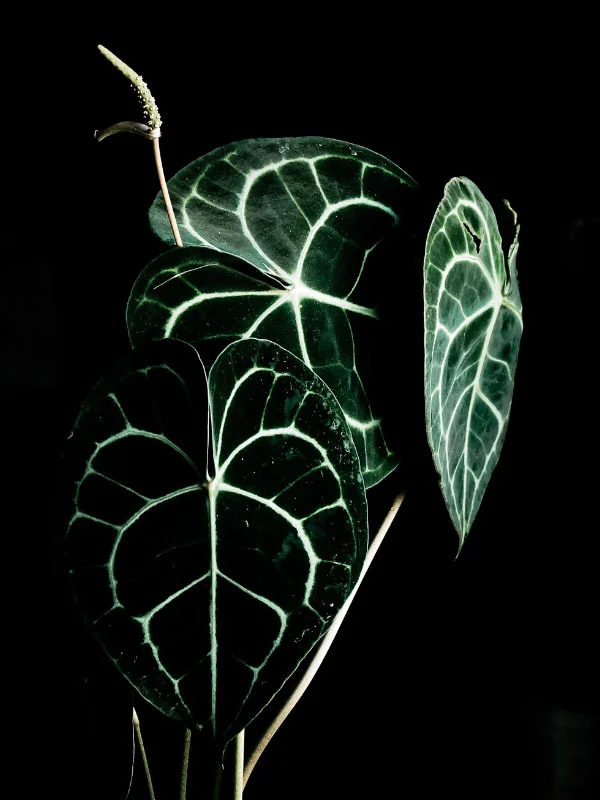
Anthurium clarinervium is another gorgeous Anthurium grown for its beautiful foliage. The plant has perfect green, heart-shaped leaves and contrasting white veins.
Caring for the plant is relatively easy. You must use a loose, well-draining potted mix, considering its epiphytic nature. The plant prefers bright, indirect sunlight with warm temperatures. Avoid soggy soil as it can lead to root rot.
17. Anthurium andreanum
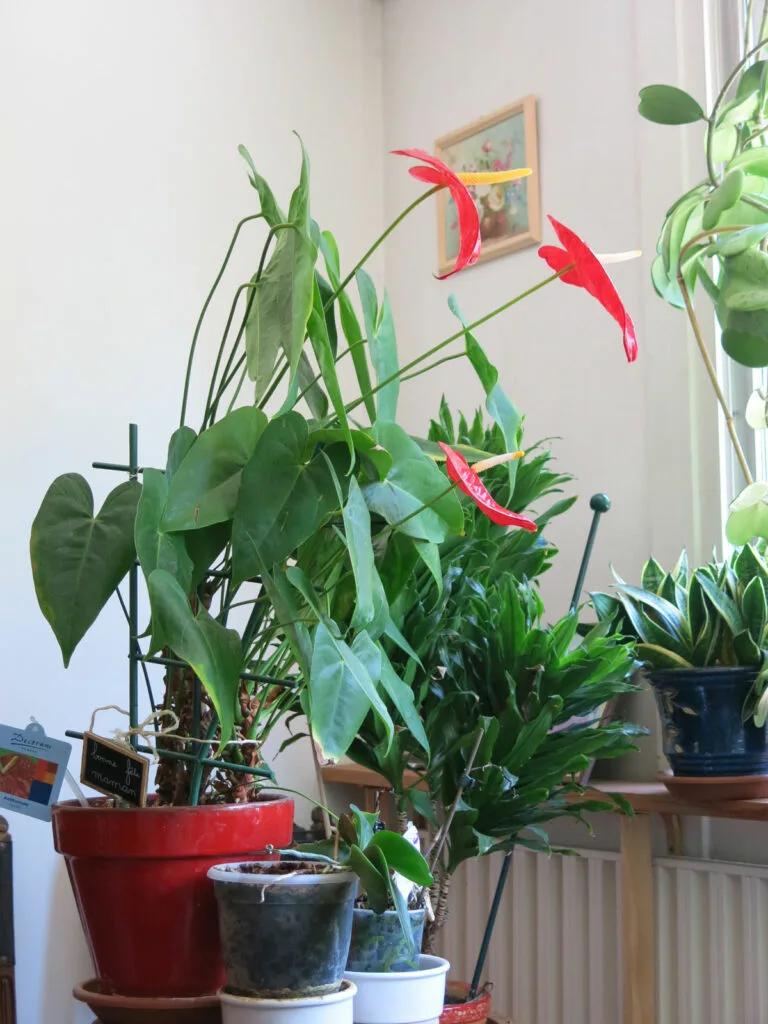
Anthurium andreanum is a must-have if you prefer colorful, attractive blooms all-throughout the year.
Also called the Flamingo flower or painter’s palette flower plant, andreanum produces inflorescences with a yellow spadix and glossy spathes in red, pink or white. The green, heart-shaped leaves offer the perfect contrast to the vibrant blooms.
The plant thrives in a warm, humid environment with partial shade. Soil moisture must be consistently maintained.
A regular dose of fertilizer can boost the plant’s growth and encourage better flowering.
18. Anthurium scherzerianum
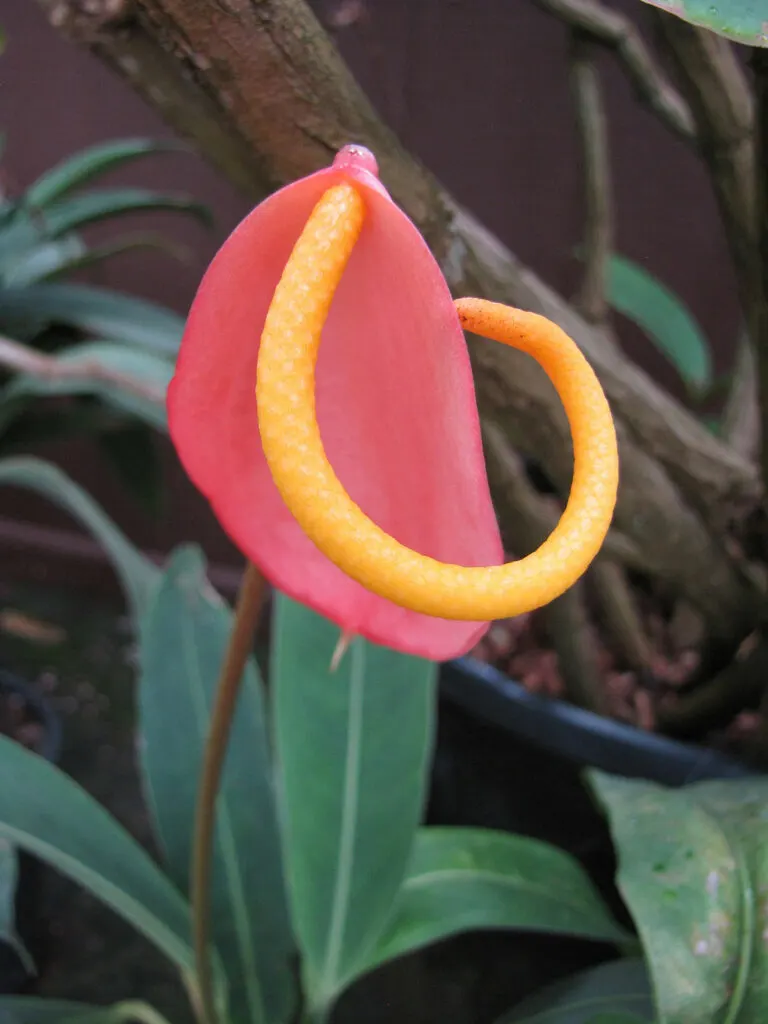
Anthurium scherzerianum produces one of the best looking blooms in the genus. The waxy, bright inflorescences come in a range of stunning hues like red, pink or orange.
The curly spadix differentiates the scherzerianum from the andreanum variety. It resembles a pig-tail earning the plant its other name, “The Pig-Tail Anthurium”.
The growing tips are similar to those of the andreanum. The plant does best with high humidity levels, warm temperatures and bright, indirect sunlight or morning sun. Restricting the plant to full shade affects the flower production and you might end up with only foliage.
19. Anthurium magnificum
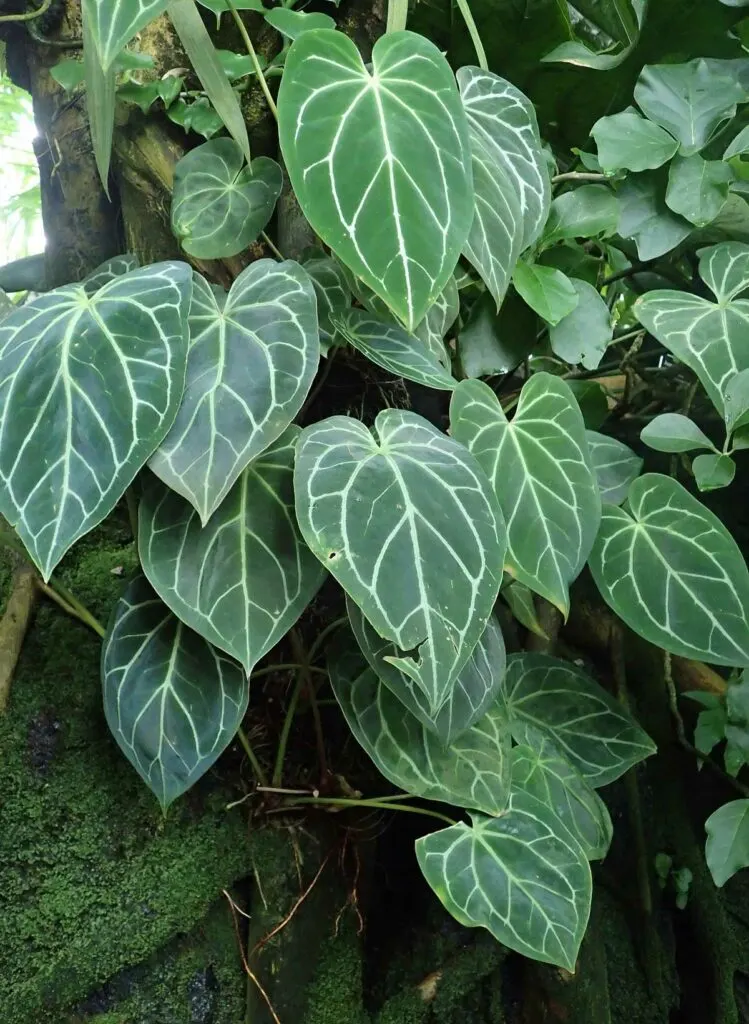
Anthurium magnificum has massive leaves in dark green or burgundy hues, bright venation and velvety surface that adds a bold statement to your room.
It is also called the tail-flower plant for the long tail-like spadix in the inflorescence.
Mimicking its natural habitat conditions like high humidity, bright, indirect sunlight, warm temperatures and loose soil will keep the plant in great condition.
20. Anthurium vittarifolium
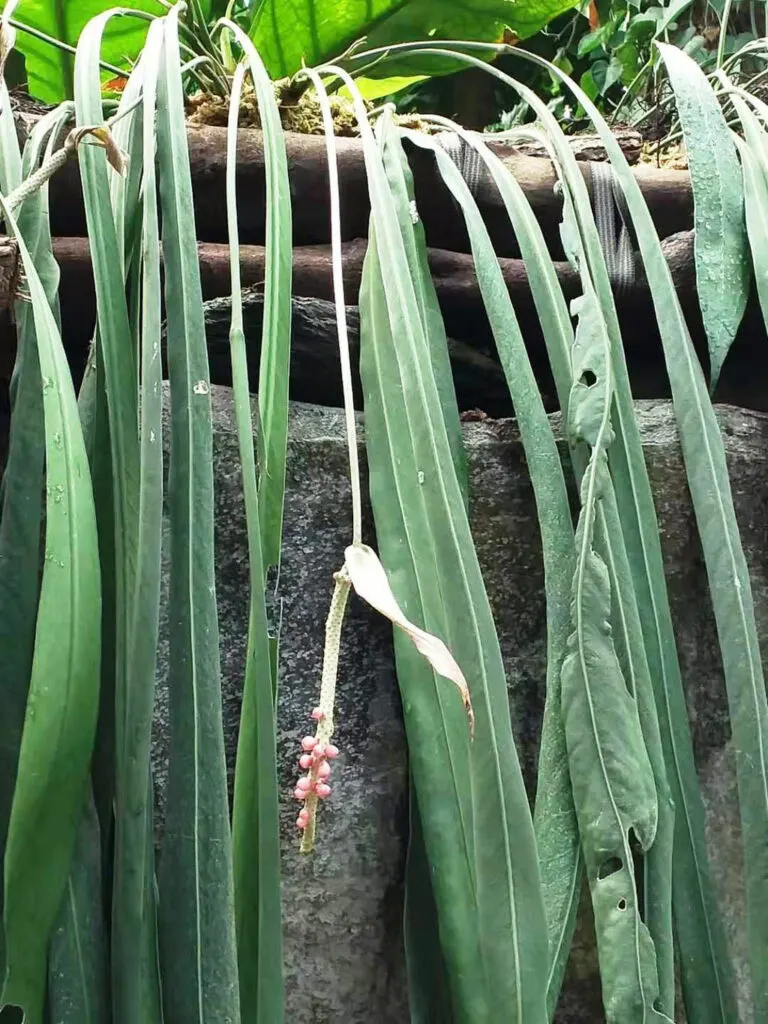
Anthurium vittarifolium is a truly special plant. It comes from South America and boasts long, strappy leaves that look like hanging ornaments.
With the right conditions, each leaf can grow up to two meters long. The plant is also called the painted tongue anthurium as it produces an inflorescence with a pink spathe and spadix.
Despite its rarity, the plant is easy to care for and maintain. It is slow-growing and prefers partial sunlight.
21. Anthurium metallicum
Anthurium metallicum is another rare and exquisite anthurium variety. The plant produces long, velvety green leaves with yellowish venation.
It has a velvety texture that glistens with light exposure. Give the plant the care it deserves and it will make for an excellent addition to your indoor garden.
The plant prefers warm temperatures with bright, indirect sunlight and consistent humidity. Soil should be loose and well-draining. Feeding it once a month in the warmer times of the year will boost the growth and keep it healthy.
Don’t you find these 21 rare and unique varieties of Anthuriums too good to resist? Being the largest genus of the Aroid plant family, there are so many other types of this species that we want to keep adding to this list.

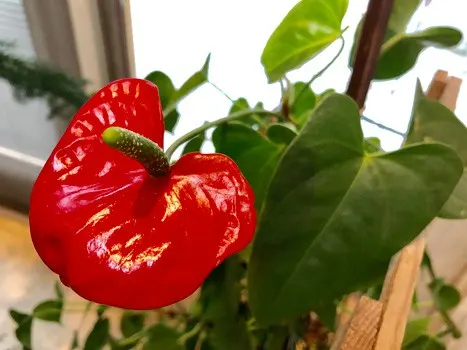
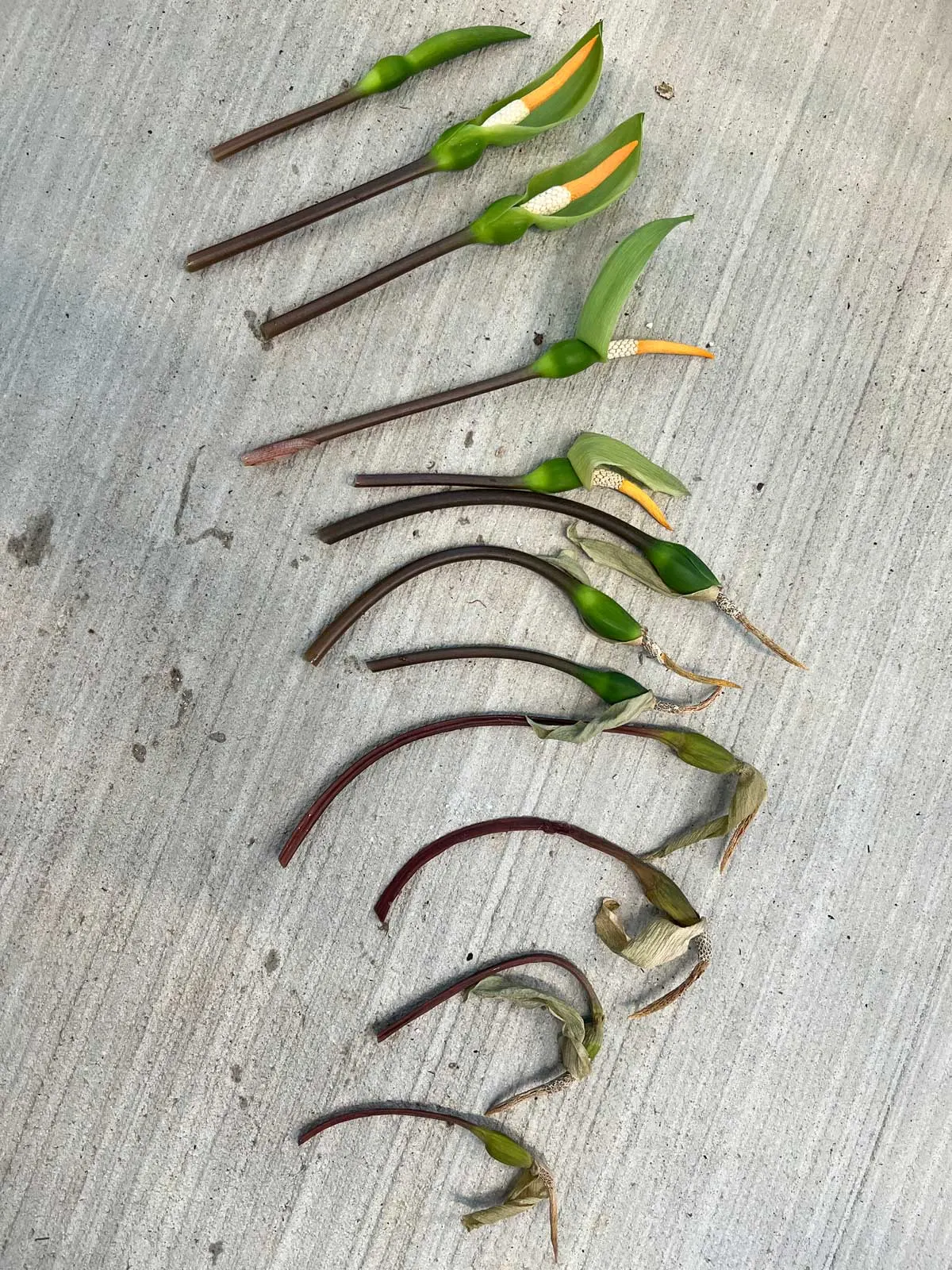
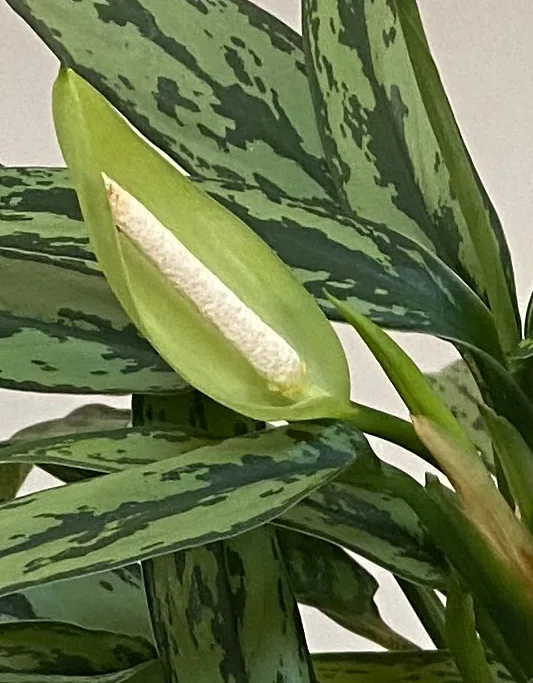
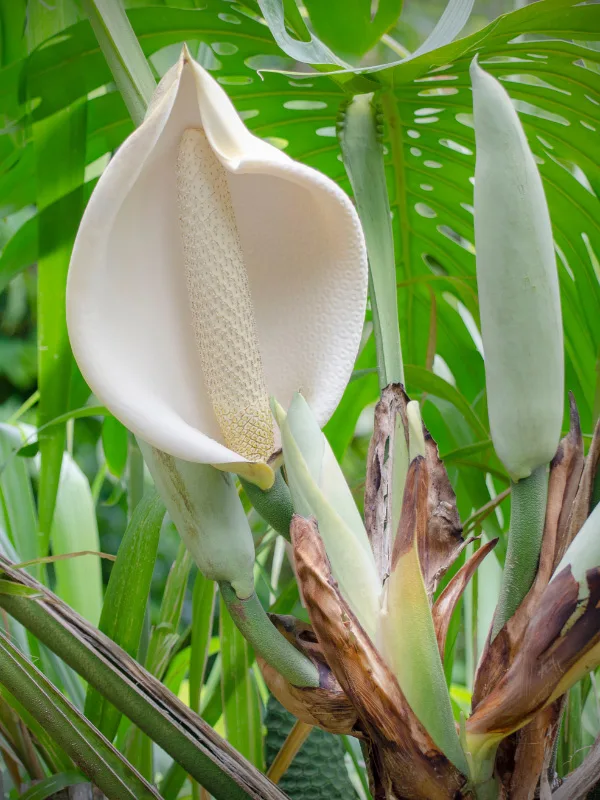
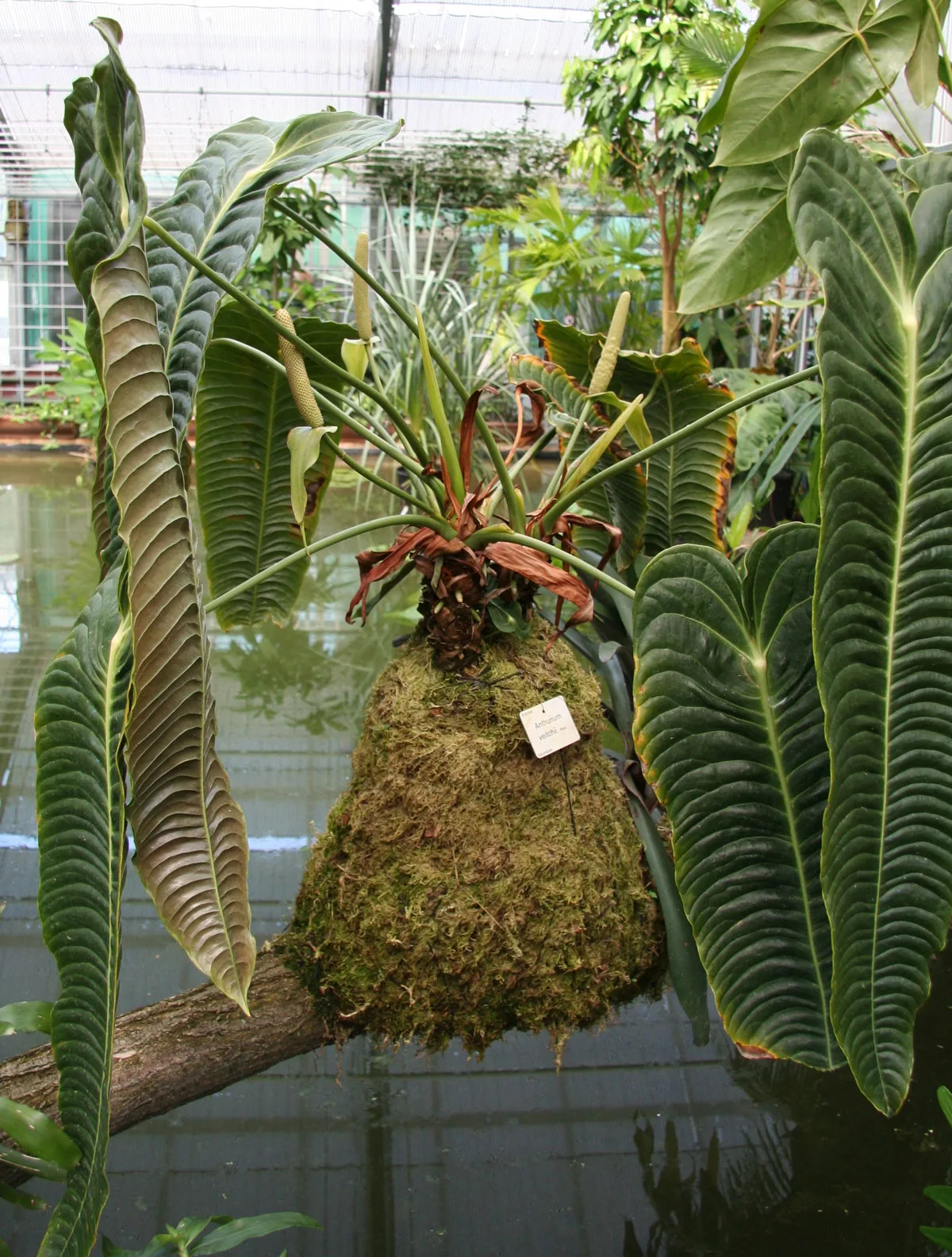

AROIDPLANT
Tuesday 6th of December 2022
complete and useful article, thank you for the information.